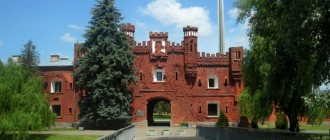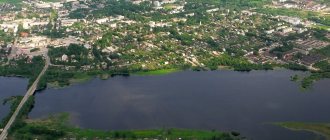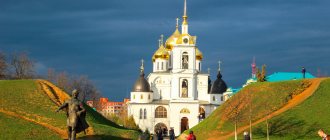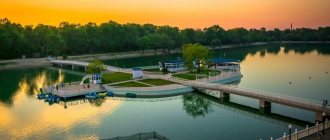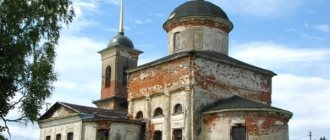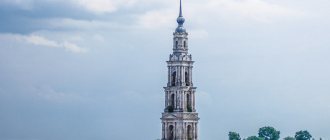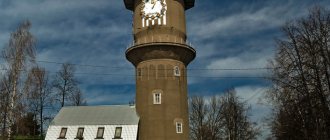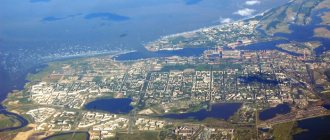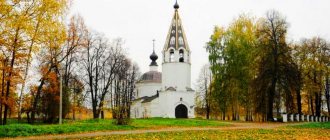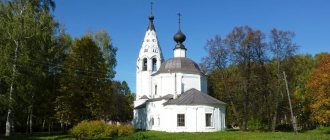Countries > Russia
Kostroma is one of the most unusual points of the Golden Ring. Each historical era has greatly changed its appearance, so now it is a city of contrasts with ancient monasteries, merchant mansions and Soviet buildings. In addition, there are many interesting museums and architectural monuments in the center and surrounding areas. What is worth visiting during your visit is in this post.
- Sights of Kostroma
- Neighborhood
- Museums
- Map
In the center
Shopping arcades
The shopping arcades are reminiscent of the former heyday of Kostroma as a center of merchants and trade in the 18th century. Walking under the arched vaults with dozens of benches, it is easy to imagine what the rows - or Gostiny Dvor - looked like at that time, because their appearance has remained virtually unchanged. Now Kostroma souvenirs, products of local farmers and artisans are sold here. There is a market inside during the daytime.
The complex is also interesting from an architectural point of view. The project considered the area of each merchant store and the arched entrance to them. A similar design of rows has been preserved in Uglich.
st. Red Rows, 1
Working hours: 10:00-19:00
Free admission
Church of the Savior in Rows
The dominant feature of Gostiny Dvor is the five-domed church of the 18th century in the pre-Petrine style. The temple fits harmoniously into the architectural ensemble of rows and complements the composition. During Soviet times, an anti-religious museum was located inside, and part of the bell tower was dismantled. Then the premises were used as a warehouse for a long time, and only in the 1990s was it returned to the Russian Orthodox Church and restored to its original appearance.
st. Red Rows, 1
Susaninskaya Square
All main streets diverge from the central square - Susaninskaya, named after Ivan Susanin, who was a Kostroma resident. There is a monument in his honor in the square.
The streets radiating from the square resemble a fan, and this layout makes it easy to navigate the center. On the main streets you will find many architectural monuments from different historical eras. At the same time, the square itself is rich in historical buildings.
Fire Tower
It is impossible not to notice the tallest building and symbol of Kostroma - the Fire Tower. Once upon a time, it delighted Nicholas I, who even regretted that there was no such tower in St. Petersburg. Until the beginning of the 21st century, it was used for its intended purpose, and now it is a museum-reserve with a historical exhibition. Similar projects can be found in other cities, for example, in Uglich.
Borschov's House
Also attracting attention is a large classical building - the Borschov House. It is difficult to imagine that such a monumental building was originally built as a residential estate. The emphasis is on the facade with an eight-column portico, which fits into the composition of Susaninskaya Square. In the 19th century, when Russian emperors and writers came to the city, they stayed there, including Zhukovsky.
Wiki/Commons
Guardhouse
The architectural ensemble of the Guardhouse Square is also completed in the style of late classicism. Previously, a guard was located here and until the beginning of the 20th century the building served its original purpose. Now it is occupied by a branch of the Kostroma Museum.
Central Park
The Kostroma Kremlin, which was once the architectural dominant of the historical center, has not survived to this day. Several churches burned down in a fire in the 18th century, and the rest were destroyed in 1934 as part of an anti-religious campaign. Now in its place is a park with a monument to Lenin and an observation deck.
Lenin monument
For the centenary of the House of Romanov, it was planned to erect a monument in his honor on the territory of the Kremlin. However, the revolution of 1917 happened, after which, of course, there could be no talk of any monument to the royal family. They decided to use the pedestal, which was already ready, for another purpose and erect a monument to Lenin on it. The discrepancy in proportions is noticeable even now - the pedestal and the monument obviously do not suit each other.
Now, from the other side, the panorama without the Kremlin seems incomplete, especially when comparing the current view with historical photographs. Work is currently underway to restore some churches of the former Kremlin, so part of the historical appearance will be recreated.
There is an observation deck in the park, which offers a beautiful view of the Volga and the embankment.
Working hours: 10:00-21:00
Free admission
Soviet street
Sovetskaya Street is the main street in the city; it runs through all the main areas from the bus station and railway station to Susaninskaya Square. Since the street crosses the entire Kostroma, it contains the most striking contrasts in the development. It preserves wooden residential houses, merchant mansions in the Art Nouveau style, ancient churches, and Soviet minimalist buildings.
Closer to the square there are good examples of Art Nouveau with characteristic expressive decor.
Also, most cafes and shops are concentrated on Sovetskaya Street.
Simanovsky Street
Another ray extending from Susaninskaya Square is Simanovsky Street. Perhaps this is one of the few places in Kostroma where the atmosphere of the ancient city has been preserved. There are no modern buildings on it, so it’s easy to imagine what it looked like several centuries ago.
Among the surviving monuments: Stozharov's house, Tretyakov's houses and other merchant mansions.
The most famous monuments and memorials
Historical monuments, monuments to famous people, sculptures decorating the streets and squares of the city.
Monument to Ivan Susanin
The first monument to Susanin was erected about a century and a half ago. However, the Soviet authorities did not like the kneeling pose of the peasant in front of the Tsar and the monument was dismantled and later destroyed. A new monument to the national hero was erected only in 1967. This is the image of a strong, tall man, with a beard, a staff and long clothes. The monument is located on Molochnaya Mountain, facing the Volga.
Monument to Yuri Dolgoruky
The monument to the Grand Duke is located in the city center. It was installed on the site of a memorial stone with a capsule of soil from the prince’s grave in the Kiev-Pechora Lavra. The height of the monument is 4.5 meters, weight – more than 4 tons. The sculpture depicts the prince sitting on a wide bench and extending his hand towards the Volga and the Trading Rows, as if showing where the city should be founded. The sculptor is V. M. Tserkovnikov.
Sculpture of the Snow Maiden
Installed in 2015 next to the city hall. The author of the project, sculptor Eremin, depicted in bronze a young girl in a fur coat and with a crown on her head. The Snow Maiden has a long braid thrown over her shoulder, and she is surrounded by forest birds and animals. It is believed that touching the bird on the Snow Maiden's hand or the girl's nose will bring good luck. The height of the figure together with the pedestal is 1.5 meters. Father Frost was present at the opening of the monument.
Monument to V.I. Lenin
The monument to the political figure is installed on a pedestal that looks more like a crypt or tomb. In 1913, it was planned that a monument with 26 historical figures would be erected on it in honor of the 300th anniversary of the reign of the Romanov dynasty. However, during the revolution, the finished, but not yet installed, bronze figures of the royal family were sent for melting down, and a monument to Lenin was erected on the pedestal.
Monument of Glory
The monument to Soviet soldiers was erected on Peace Square in 1972, on the day of the Victory celebration. It depicts a young warrior rescuing a teenage boy. The sculptors of the monument are Levitskaya and Baburin, the architect is Kutyrev. Every year on May 9, ceremonial rallies and parades are held at the Monument of Glory, war veterans and city residents gather to lay flowers and honor the memory of fallen soldiers.
Memorial "Eternal Flame"
Located on Mira Avenue. The basis of the memorial complex is represented by several high pylons made of white marble, against the background of which a sculpture of the Motherland laying a wreath and a soldier are installed on a pedestal. At the foot of the pedestal there is a bronze star, in the center of which the Eternal Flame burns. The names of the soldiers buried in the mass grave are engraved on granite slabs. There is a chapel nearby.
Wooden architecture
To see the amazing carved decor and platbands of wooden houses, be sure to take a walk along Shagova, Sennaya and Engels streets. Over time, architectural monuments and wooden decor are becoming more unique and rare, so wherever this heritage has been preserved, you should try to visit such neighborhoods.
In addition to wooden houses, Kostroma has many red brick buildings from the early 20th century. The outskirts are built up with Soviet panel houses and new high-rise buildings.
Neighborhood
Holy Trinity Ipatiev Monastery
Not far from the center there is an ancient monastery, very important from a historical point of view. Firstly, once upon a time it was within its walls that the Ipatiev Chronicle was found - one of the oldest documents and sources of information about ancient Rus'.
Secondly, the Ipatiev Monastery was captured by False Dmitry II and even turned into a real armed fortress.
Thirdly, it was here that the Time of Troubles was put to an end, through a ritual for the reign of Mikhail Romanov. Due to this, it is considered an important place in the history of the Romanov dynasty. Museum exhibitions located in the monastery premises will tell you more about the history.
Photo from Wikipedia.
st. Prosveshcheniya, 1
Time: 09:00-17:30
Entrance: 150 rub.
Kostroma Sloboda
Near the monastery there is another interesting point - the Ethnographic Village, which recreates peasant life and stores important household items of that time. The museum-reserve also stores important architectural monuments transported here from territories flooded during the creation of the Gorky Reservoir.
Znamensky Monastery
While other Kostroma monasteries are popular among tourists, the Znamensky Monastery rarely makes it onto tourist routes. That is why it is worth coming here for the real atmosphere of monastic life, peace and quiet. It is surprising that the monastery was founded relatively recently and unites two ancient churches - the Resurrection of Christ and Znamenskaya.
The Church of the Resurrection of Christ on Debra deserves special attention. The five-domed composition is surrounded by galleries with hipped porches, and next to it is the Holy Gate with two expressive arches and rich decoration. Previously, the facade was decorated with bright paintings and decorative details, but, unfortunately, all of them have not been preserved.
Wiki/Commons
st. Nizhnyaya Debra, 37
Time: 08:00-17:00
Free admission
Elk farm
The Sumarokovskaya farm is a rare place with domesticated moose, which you can feed and take pictures with. You will have to get to the farm yourself by car or with a tour.
village Sumarokovo
Time: 10:00-15:00
Entrance: 100-150 rub.
Nearby cities
In the neighborhood of Kostroma there are many interesting places where you can go for one day: Yaroslavl, Ivanovo, Bui. In addition, the region has many ancient towns with a rich history, for example, Nerekhta and Krasnoe-on-Volge.
City infrastructure
Our long-suffering housing and communal services have broken many copies. He is regularly encouraged in the media and on the Internet, but this does not give much effect. Kostroma is no exception here. Old communications and the disrepair of the dilapidated foundation are pressing problems of the urban economy, which are only getting worse over time.
The emergency housing and communal services service, especially in winter, works in emergency mode, eliminating regular breakdowns on heating mains. Therefore, residents of multi-storey buildings are often left without hot water for weeks. In this case, many have long stocked up on water heaters, making their electric meters spin faster. It’s good that at least planned shutdowns of hot water in the summer are not practiced.
Another pressing problem of the urban economy is clearing the streets of snow. Snowdrifts are not removed from central streets; everyone has come to terms with this a long time ago. And the sidewalks, even on the central streets, are an impassable mess of snow and sand-salt mixture in winter. And the courtyard areas are not cleaned at all. And if a stray harvesting tractor appears somewhere and clears the road, the happy residents of a particular yard dance merrily and beat tambourines.
Kostroma’s special pain is our roads. The condition of the road surface cannot be assessed. Even the federal target program, under which the city received and “used” 15 billion rubles for road repairs, did not help this. With this money it was possible to cover the whole of Kostroma with new asphalt... But even the little that was done returned to its original state after 3 years.
The average resident has few options: buy a car with an indestructible suspension, or regularly go to car repair shops; fortunately, Kostroma has no shortage of them: demand creates supply. There are also a lot of cars on the city streets with stickers on the rear window: “I pay taxes, where are my roads???” And my soul becomes a little lighter, as if I did everything I could.
City transport in Kostroma is represented by a trolleybus and bus fleet, which is in deplorable condition. The cars are mostly old, semi-damaged. The PATP-4 bus fleet, for example, is equipped with Turkish-assembled Mercedes, half of which have long been written off. However, the city has not paid for the buses since 1996.
And in 2011, the only motor transport company in the city, PATP-4, went bankrupt, and they had to rely only on minibuses, a sort of Frankenstein of the market economy.
True, new PAZ trucks arrived in the city quite recently, but these 30 carts are not able to solve the city’s transport problem. But each one has a GLONASS system, the economic effect of which is very doubtful.
Therefore, citizens have to take responsibility in transport matters, or entrust their fate into the hands of the glorious driver of the Gazelle minibus. Of course, those who could, acquired an iron horse, and more than one. Almost every third family has a car, which partly smoothes out the crisis of public transport in the city.
Traffic across the Volga
Fortunately, there is no need to talk about traffic jams as a phenomenon in Kostroma yet. There is only difficulty in traffic on the only road bridge in the city across the Volga during rush hours. And also on the central street of the city - Sovetskaya, mainly due to incorrect traffic light regulation and the narrowness of this very street. Therefore, public transport stops create serious obstacles to the main traffic.
Museums
Historical
The exhibition is located on the first floor of the Fire Tower on Susaninskaya Square. The museum will introduce you to the history of the city and region.
Wooden architecture
It is located not far from the Ipatiev Monastery and consists of unique centuries-old wooden buildings. In addition to the exterior wooden decor, the buildings and churches have restored historical interiors and furniture.
Wiki/Commons
st. Prosveshcheniya, 1B
Time: 09:00-17:00
Entrance: 100-150 rub.
Flax and birch bark
The exhibition will tell about the ancient origins of the use of flax and birch bark, the cultural traditions of the region and the country as a whole associated with these materials.
st. Tereshkova, 38
Time: 09:30-17:00
Entrance: 50-100 rub.
Nature of the Kostroma region
The museum's dioramas will show the diversity of nature and animals. Reconstruction of scenes from the animal world and a petting zoo will be of interest to both adults and children.
st. Milk Mountain, 3
Time: 10:00-18:00
Entrance: 80-120 rub.
Crime
Kostroma has never been a leader in reports of high-profile criminal cases. Of course, in the 90s, organized crime groups organized by former “athletes” ruled the city. But there was no lawlessness in the city even in those distant times. Over time, control over the city passed into the hands of the “siloviki”, and the brothers quietly disappeared into the business environment.
In the last 5 years, the main resonance in the field of law and order in the city was associated with the personality of the former governor of the Kostroma region. With the help of local bloggers, the nickname of the dark wizard from the Harry Potter saga was assigned to him on the Internet: TKNN (He Who Must Not Be Named).
During his short term as governor, TCNN managed to ruin relations with absolutely everyone, from local businesses to the Kostroma judiciary and even its deputies. The general election of the mayor was cancelled, and the city was effectively deprived of its independence and transferred to “manual control”.
Abuse of power, police pressure and persecution of undesirables were actively discussed on the Internet. Indicative was the fabricated criminal case of the alleged beating of the governor’s son in a Kostroma bar. After the governor was removed “at his own request,” the defendant in this case was acquitted.
The opening of the new clothing market “Solnechny” at the beginning of 2012, which took place under the personal patronage of the governor, also raised many questions and prosecutorial checks. Not only was the facility opened without permission to put into operation, but the roof of the new building had already leaked and flooded dozens of retail outlets.
In contrast to the economic component, the general crime climate of Kostroma can be called favorable. There is a trend towards a decrease in serious and especially serious crimes. If you avoid visiting working areas at night and do not provoke others with your actions, you can be sure of your safety.
Where to stay
Kostroma has quite a large selection of accommodation, including budget hostels, good hotels, and private apartments. It is better to choose housing in the center, since the difference in price will be small and you will not have to waste time on the road.
It’s easier to choose the right option in the Hotellook aggregator, since the prices of all popular search engines, including Booking, are immediately presented there.
Private housing, including apartments and houses in the region, is more convenient on Sutochno.ru in Kostroma
